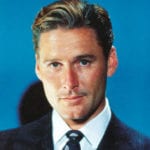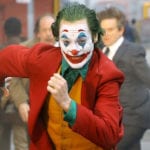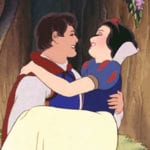 Creepy
Creepy  Creepy
Creepy  Technology
Technology 10 Scientific Breakthroughs of 2025 That’ll Change Everything
 Our World
Our World 10 Ways Icelandic Culture Makes Other Countries Look Boring
 Misconceptions
Misconceptions 10 Common Misconceptions About the Victorian Era
 Mysteries
Mysteries 10 Strange Unexplained Mysteries of 2025
 Miscellaneous
Miscellaneous 10 of History’s Most Bell-Ringing Finishing Moves
 History
History 10 Great Escapes That Ended Right Back in Captivity
 Weird Stuff
Weird Stuff 10 Fascinating Things You Might Not Know About Spiders
 Food
Food 10 Everyday Foods You Didn’t Know Were Invented by the U.S. Military
 History
History 10 Odd Things Colonial Americans Kept at Home
 Creepy
Creepy 10 More Representations of Death from Myth, Legend, and Folktale
 Technology
Technology 10 Scientific Breakthroughs of 2025 That’ll Change Everything
 Our World
Our World 10 Ways Icelandic Culture Makes Other Countries Look Boring
Who's Behind Listverse?

Jamie Frater
Head Editor
Jamie founded Listverse due to an insatiable desire to share fascinating, obscure, and bizarre facts. He has been a guest speaker on numerous national radio and television stations and is a five time published author.
More About Us Misconceptions
Misconceptions 10 Common Misconceptions About the Victorian Era
 Mysteries
Mysteries 10 Strange Unexplained Mysteries of 2025
 Miscellaneous
Miscellaneous 10 of History’s Most Bell-Ringing Finishing Moves
 History
History 10 Great Escapes That Ended Right Back in Captivity
 Weird Stuff
Weird Stuff 10 Fascinating Things You Might Not Know About Spiders
 Food
Food 10 Everyday Foods You Didn’t Know Were Invented by the U.S. Military
 History
History 10 Odd Things Colonial Americans Kept at Home
10 Intense Old Hollywood Rivalries
It always comes as a shock when it’s revealed that two Hollywood coworkers never actually got along despite their charisma on screen. From Ryan Gosling and Rachel McAdams in The Notebook to the disastrous relationship between Dakota Johnson and Jamie Dornan behind the scenes of Fifty Shades of Grey, actors have been able to repeatedly fool us into thinking there was some substance behind their portrayal, because—well—it is their job.
But Hollywood rivalries and rocky relationships aren’t a completely new phenomenon. Classical Hollywood stars didn’t get along quite as well as you might think.
10Bette Davis & Joan Crawford
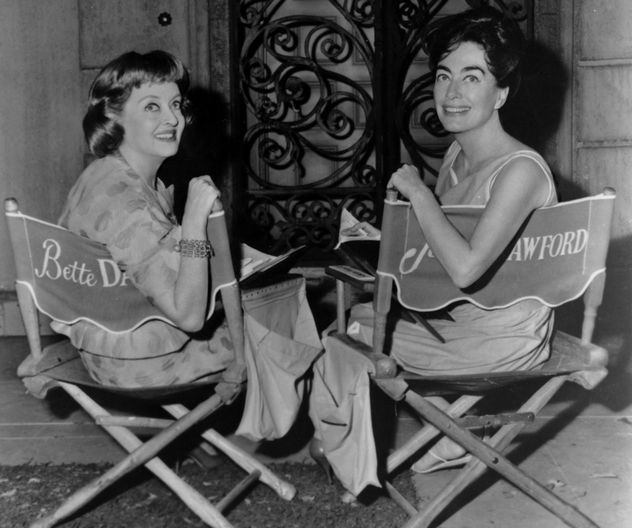
As two of the biggest female stars in Hollywood history, the bitter feuds between Joan Crawford and Bette Davis have become the stuff of legend. However, there are numerous rumors as to how this rivalry arose. Reporter Michael Thornton, who was close to Davis, suggested that she had been humiliated when the bisexual Crawford attempted to hit on her. However, Davis hinted that the unbreakable hatred began when Crawford married Franchot Tone, a man Davis was in love with. Davis stated, “I have never forgiven her for that and never will.”
After years of competing for roles, Crawford and Davis finally came to a head in the infamous Whatever Happened to Baby Jane? What was supposed to be acting turned into physical abuse. Crawford suffered a head wound that required stitches after Davis kicked her in one scene. In turn, Davis claimed that she almost broke her back when she was required to carry Crawford on the set, because Crawford had chosen to wear a weighted belt during the scene.
But whichever side you take, it became clear after their deaths that neither of the actresses were angels. Crawford’s adopted daughter gained fame with her infamous account of the physical and emotional abuse she suffered in Mommie Dearest, while Davis’s daughter made similar accusations about Davis in My Mother’s Keeper.
9Olivia de Havilland & Joan Fontaine
Both Olivia de Havilland and Joan Fontaine were incredibly successful, Oscar-winning actresses, but their behavior toward one another wouldn’t suggest that they were sisters. The two women made no secret of their hatred, which supposedly began when they were children. Fontaine’s autobiography paints a picture of de Havilland as aggressive and abusive—even purposefully attempting to fracture her younger sister’s collarbone on one occasion—while interviews with the two sisters suggest an element of jealousy in the relationship. De Havilland’s career took off a lot earlier than Fontaine’s, and Fontaine complained that she was seen as “the usurper” by her mother.
By the 1940s, the two were competing for Hollywood roles and Oscar nominations. In 1942, they came head-to-head when Fontaine won an award for her role in Suspicion over her older sister. When de Havilland won her own Oscar in 1947, she refused to shake the host’s—Fontaine’s—hand. The two also competed for men: Fontaine’s first marriage was to her sister’s previous boyfriend.
The estrangement between the two only increased with their mother’s death in 1975. Fontaine claimed that de Havilland refused to invite her to the funeral, whereas de Havilland claimed that Fontaine had been too busy to attend. The sisters did not speak for over 35 years after the event, up until Fontaine’s death in 2013.
8Laurence Olivier & Marilyn Monroe
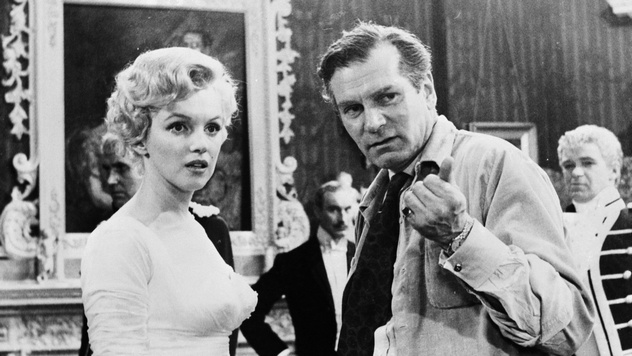
Although he was one of Britain’s finest actors, Laurence Olivier was once described by Sir Alec Guinness as “unpleasant” and “vindictive.” In tapes used for his memoirs, Olivier is bitterly critical of even his most famous co-stars, annihilating the careers of Joan Fontaine, Merle Oberon, Kirk Douglas, and Marlon Brando. Orson Welles wasn’t the biggest fan of Olivier, either, at one point calling him “seriously stupid.”
However, it was for Marilyn Monroe that Olivier claimed his hatred was the strongest. Monroe and Olivier worked together for the first time in The Prince and the Showgirl, and their memoirs paint a vivid picture of their disdain for each other. Monroe was decidedly shy and nervous on set and spent as little time with other cast members as possible. Olivier despised her use of “method acting” and the constant presence of her coach, Paula Strasberg. Another actress who worked on the film, Jean Kent, described Monroe as “grubby” and “disheveled,” claiming that other co-stars took to drink in order to get through the long process of filming with her.
However, Jack Cardiff, who worked as a cinematographer on the film, claimed that Olivier set out to purposefully humiliate the young actress, regarding her as “inferior.” He constantly referred to Monroe as a “bitch” and refused to acknowledge her status as a sex symbol, something she never forgave him for.
7Orson Welles & William Randolph Hearst
When Citizen Kane was released in 1941, Orson Welles was already one of the most prominent members of Hollywood and a true jack-of-all-trades. Hearst, on the other hand, was a monumental newspaper mogul. He was so influential, it’s rumored that when Frederick Remington, a frontline photographer, complained that there was not enough warfare to shoot in Cuba, Hearst replied, “You make the pictures, I’ll make the war.”
For those of you who have seen the film, you might recognize the similarity of this quote to one made by Charles Foster Kane. This, of course, sparked the idea that the whole movie was based on Hearst himself, something that did not sit well with the publisher, who banned all of his newspapers from even mentioning it. Although he allegedly never saw the film, Hearst tried to buy and burn the reel before it was released and attempted to blackmail exhibitors into boycotting the movie.
He was supposedly especially angry with the depiction of the drunk, failed opera singer said to be based on his wife. In interviews, Welles even claimed that Hearst hired an underage prostitute and a photographer and paid them to wait in Welles’s hotel room, ready to create a scandal big enough to end his career. But Welles was informed by a police officer before the event took place and managed to escape any humiliation.
6Charlie Chaplin & Louis B. Mayer
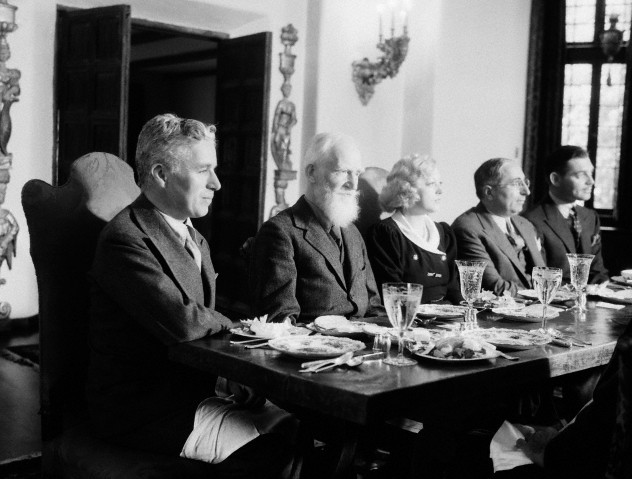
By 1918, Charlie Chaplin was one of the biggest movie stars in the world, and Louis B. Mayer was one of Hollywood’s greatest producers. It was around this time that Chaplin also met his first wife, 16-year-old child star Mildred Harris—a struggling actress and the cause of the Mayer-Chaplin quarrel.
Their marriage lasted a little over a year. Chaplin felt he had been tricked into it when Harris began circulating false rumors that she was pregnant. Chaplin admitted that although he at first found the prospect of “educating” Harris attractive, he soon grew frustrated, feeling that she was intellectually inferior to him and that she had lost her youthful vibrancy. In turn, Harris said that Chaplin was short-tempered and made her feel inferior. The loss of their first child pushed the couple over the edge.
Mayer was known for his pragmatism and saw opportunity in signing on a former child star who had been the cause of so much publicity during her divorce from Chaplin. Tensions came to a head between the two when Mayer made a comment about the divorce, purportedly calling Chaplin a “pervert.” Chaplin accused Mayer of using his name and capitalizing on his marital troubles for profit, because Mayer intended to bill Harris as “Mrs. Charlie Chaplin.” Chaplin then took an unsuccessful swing at Mayer, who quickly hit back, landing Chaplin in a nearby potted plant.
5Brigitte Bardot & Henri-Georges Clouzot
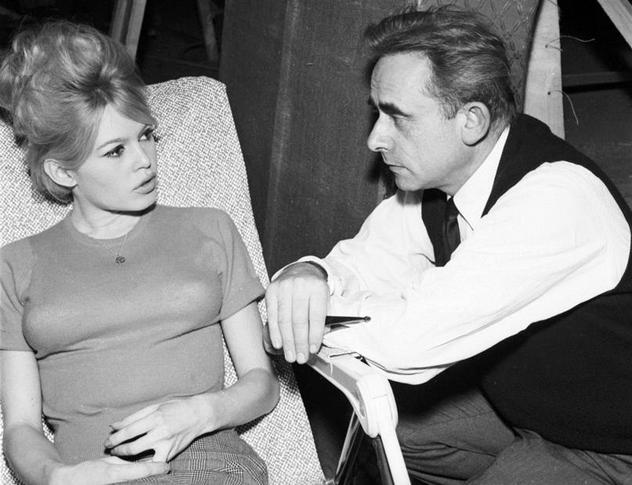
La Verite—or, The Truth—is an Academy Award–winning movie, considered one of both Bardot’s and Clouzot’s best. However, things on set never went very smoothly. Bardot said of Clouzot that he was “a negative being, forever at odds with himself and the world around him.” In France, his films were incredibly controversial at the time, and he was both admired and hated by critics and the public alike.
By the end of his career, Clouzot had become notorious—not just for his films but also for his violence toward women on set. One scene in The Truth took place after Bardot’s character had unsuccessfully tried to commit suicide by overdosing on sleeping pills. Instead of trusting her to be able to pull it off convincingly, Clouzot gave Bardot some actual sleeping pills, telling her that they were painkillers. He then waited until she was drowsy, drooling, and heavily perspiring. During other scenes, Bardot was forced to drink whiskey to emulate her character’s emotional exhaustion.
Bardot was far from the submissive stereotype that Clouzot usually hired, though, and when he shouted insults at her in an attempt to make her cry, she only laughed. He then tried to slap her, but she hit him back before leaving the set and refusing to return until he had apologized. In another incident, Clouzot shook Bardot by the shoulders, telling her that he needed an “actress” not an “amateur,” to which she replied that she needed a “director” not a “psychopath.” Although she would later say it was one of her favorite films, Bardot admits that she never got along with the famed director.
4Faye Dunaway & Roman Polanski
Roman Polanski is by no means someone to look up to. Despite his triumphs in cinema, his history of rape and pedophilia puts a real question mark over his character. While filming the 1974 movie Chinatown, tension between Polanski and the lead actress, Faye Dunaway, became so unpredictable that it is still a sore spot for both parties today. In one interview, Polanski claimed that Dunaway struggled to accept her role and take on board his advice and that she was so difficult, he nearly considered halting filming altogether. Polanski was by no means the innocent party, though. Rumors state that when Dunaway asked for guidance on her character, he shouted, “Say the f—ing words!”
Polanski was also physically abusive. At one point, he was so frustrated by a stray hair on Dunaway’s head that he plucked it out before even asking her to tuck it away. This haute tension supposedly culminated in the most dramatic way possible: When Polanski refused to allow Dunaway a toilet break, she responded by peeing into a nearby cup and throwing it into his face. Make sure not to ask her about it, though. The last time a reporter brought the subject up, he was screamed at and thrown out onto the street.
3Sophia Loren & Jayne Mansfield
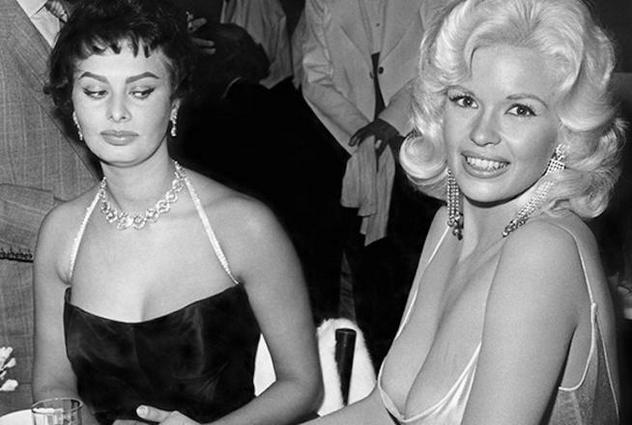
It was the face that launched a thousand side-eyes. The above photo became an iconic example of how to throw shade. But what was the story behind the notoriously catty picture? In 1957, Sophia Loren—who had just rocketed to Hollywood fame from Europe—decided to host her own Beverly Hills party, inviting the biggest and most influential stars of the time. Aspiring actress and nightclub entertainer Jayne Mansfield had also been invited, and she was the last to arrive. Mansfield had already gained a reputation for using high-profile events to stage “accidental” mishaps that boosted her own media presence.
Loren no doubt knew this herself. She explains that when Mansfield waltzed over to her table in a revealing dress and planted herself next to Loren, the whole room was watching. The event was intended as Loren’s introduction to the Hollywood circuit, but Mansfield was stealing the show. Despite years of speculation, it wasn’t until decades later that Loren explained just what she was thinking about when the historic photograph was taken: fear of a monumental wardrobe malfunction.
Loren said she felt sorry for Mansfield and her choice of dress and was staring “at her nipples because I [was] afraid they [were] going to come onto my plate.” Other photographs surfaced from the night where the two seem far more relaxed, but Loren maintains that it was this picture that best represents how she felt toward Mansfield. Despite this, Loren refuses to sign copies of it out of respect for the late actress, who passed away 47 years ago.
2Betty White & Bea Arthur
Back in the 1980s, hit TV show The Golden Girls was the epitome of female friendship. It focused on four women—Dorothy, Blanche, Rose, and Sophia—and their adventures and exploits in Miami throughout their “golden years.” However, despite the endearing portrayals, their friendships did not extend off camera.
Most tense was the relationship between Betty White and Bea Arthur, who were so dissimilar that they refused to talk to each other off set. Everything from their acting methods to their diets was completely different. Arthur was a classically trained stage actress who despised postmodern concepts, such as breaking the fourth wall, while White had started in television and would openly flirt with the audience. It seemed that literally anything White did would drive Arthur up the wall—whether she ordered the same food every day for lunch or arrived at work with a particularly positive attitude. They were polar opposites: Arthur, the consummate professional, and White, the outgoing celebrity.
Most of these stories come from White herself or coworker Rue McClanahan. Despite this, both actresses remember Arthur, who passed away six years ago, very fondly. White attests that she absolutely loved and admired Arthur and attended her one-woman shows multiple times, despite the splinter in their personal relationship. McClanahan’s fondest memory of Arthur was the Thanksgiving after McClanahan’s mother died; Arthur demanded that McClanahan stay with her so she could cook her dinner and tuck her away into bed.
1Gene Kelly & Debbie Reynolds
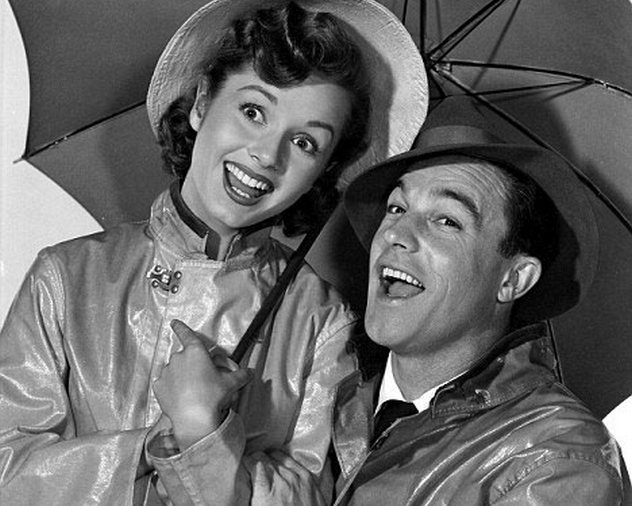
Although Singin’ in the Rain is one of the happiest classics out there, the set behind it was anything but. The cinematic masterpiece largely owed its success to the genius of Gene Kelly, but it didn’t come without a price. Kelly’s hardworking demeanor bordered on obsession, and there was little luck for anyone who couldn’t keep up. Debbie Reynolds, who played the female lead, was completely new to the Hollywood scene and only 17 at the time. She had little experience in acting—and even less in dancing—but had only a few months to learn it all.
Reynolds believes that Kelly never wanted her in the film in the first place, remembering how he just stared at her when they first met and she admitted she’d never danced before. For the “Good Morning” scene, O’Connor and Reynolds danced nonstop from 8:00 AM to 11:00 PM. They weren’t allowed to stop even when Reynolds’s feet were bleeding. If Reynolds didn’t look enthusiastic enough, Kelly would shout at her until she cried. After one hard day’s work, Reynolds had to be carried to her dressing room, because she had burst some blood vessels in her feet. Then Kelly ended up using one of the first takes anyway and dubbed over the sound of her feet himself.
Reynolds remembers Fred Astaire with particular kindness, recollecting the time she was so upset, she hid under a piano, crying, and Astaire came over to comfort her. Today, Reynolds is thankful for the hard times Kelly put her through, because it helped her become a better performer. Kelly previously stated his surprise that Reynolds still talked to him after his nastiness on set.
Kitty is a history student and likes to daydream. You can read more of her musings at www.kittywritesstuff.com or follow her confused ramblings on Twitter.
